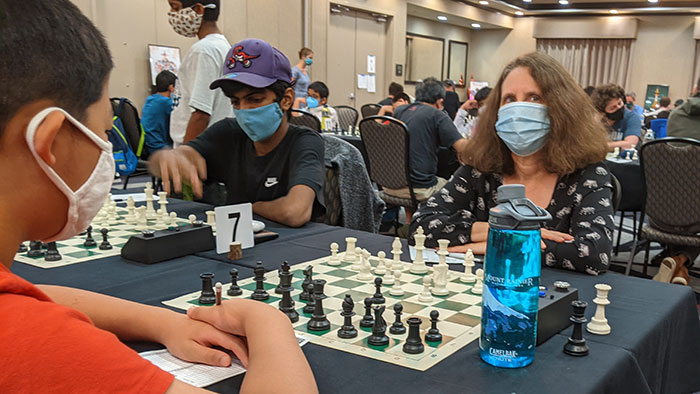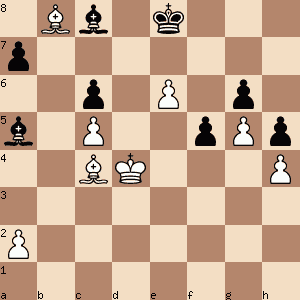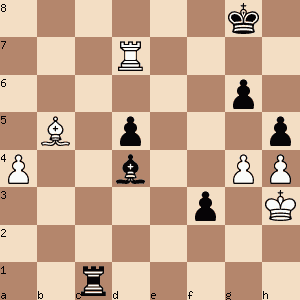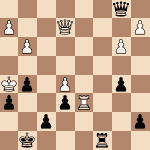On behalf of the Alliance Chess Club, Louis A. Reed Jr. organized and directed the Fourth Annual Queen City of the Prairie Open & Fort Worth Championship on July 17–18, 2021. Although I scored just 3 points out of 5 rounds, I split the first expert prize with my last-round opponent. My fourth-round opponent missed turning his losing position into a draw. In round 5, I turned my winning position into a draw.
Chess Tournament Conditions
Louis A. Reed Jr. and his wife Wendy run weekly meetings of the Alliance Chess Club and monthly US Chess-rated tournaments with low entry fees and small prizes. If I lived closer to the Alliance Chess Club, I would visit it often for the friendly atmosphere provided by the Reeds, which I wrote about in this article.
For the past four years, the Alliance Chess Club has run an annual FIDE- and US Chess-rated open. I have driven the 35 minutes (one-way) each year for the Queen City of the Prairie Open & Fort Worth Championship, because its conditions are excellent. In most U.S. tournaments, players bring their own chess boards, chess sets, and chess clocks. Reed provides all that equipment.
Reed also enforces rules that help safety and decorum. All players wore masks over their noses and mouths. Players who annoyed their opponents—for example with repeated draw offers, adjusting chessmen on their opponents’ time, or ringing cell phones—got appropriate warnings and penalties.
The top boards, with wooden pieces and boards, were spaced so that neighboring boards were not near each other. The very top chess board was handmade by Wendy Reed. The lower boards, where I spent part of my tournament, had vinyl mats and plastic pieces. Each player was an arm’s length from his or her neighbor. Although the lower boards were comfortable, there was incentive to win each round and move up to the top, more luxurious boards.
Photos in this article were taken by Louis A. Reed Jr.
Round 4

I was on a lower board for round 4, as I had scored 1.5 out of 3 against lower-rated opposition in the first three rounds. I had an advantage against my fourth-round opponent, Oscar Li, almost all game. But he missed a chance to turn my winning position into a draw. Do you see where he should move, as Black?

39…a6? [Too slow. Black had to go after White’s kingside pawns. He reflexively saved his a-pawn, a mistake similar to what I played in Round 5.]
[39…Be1 40.Ke5 (40.Bxa7 Bf2+ 41.Kd3 Bxh4 42.Bb8 Bxg5 43.a4 And White should be able to hold a draw. But Black is the one with the edge.) 40…Bg3+ 41.Kf6 Bxb8 42.e7 Be5+ 43.Kxe5 Kxe7 In this line also, Black has the advantage but White has drawing chances.]
40.Ke5 [Now White is completely winning.]
You can see how the game played out below:
Round 5
In round 5, I was paired against Vaseegaran Nandhakumar who, like me, was vying for the top expert prize. The third expert-rated player in the tournament, Alexander Deatrick, tied for first place so did not figure in the expert prize money.
Against Nandhakumar, I had a huge advantage for most of the game. But I failed to play the winning plan at the end. My thought was to defend my d-pawn, which was attacked. It’s the same materialism that cost my fourth-round opponent his chance to draw. Instead, I should have seen the forced checkmate. In the diagrammed position, it’s Black (me) to move. White found a great response to my blunder.

48…Rc5?? [Turning a win into a draw, all because I want to hold onto my d-pawn.]
[48…Be5! Threatening …Rh1#. White has no effective defense. Black will win. 49.gxh5 gxh5 50.Rd8+ Kg7 51.Bf1 Rxf1 52.Rd7+ Kf6 53.Rf7+ Kxf7 54.a5 Rh1#]
It’s only fair that I shared in this article how I put my winning position at risk in round 4 and turned my winning position into a draw in round 5. I wrote about how others did the same thing, in this article.

Hi, I was your opponent for round 4. I found your article while at school. Nice job on the analyzation part! Thanks for playing with me! It’s so exciting to play a titled player.
Thank you so much for this insightful article. It’s amazing how the optimal move in a position can be, at times, so counter intuitive. Of course, the silicone monster easily finds the best move, and then us mere mortals can all laugh (or cry as the case may be) about it later.